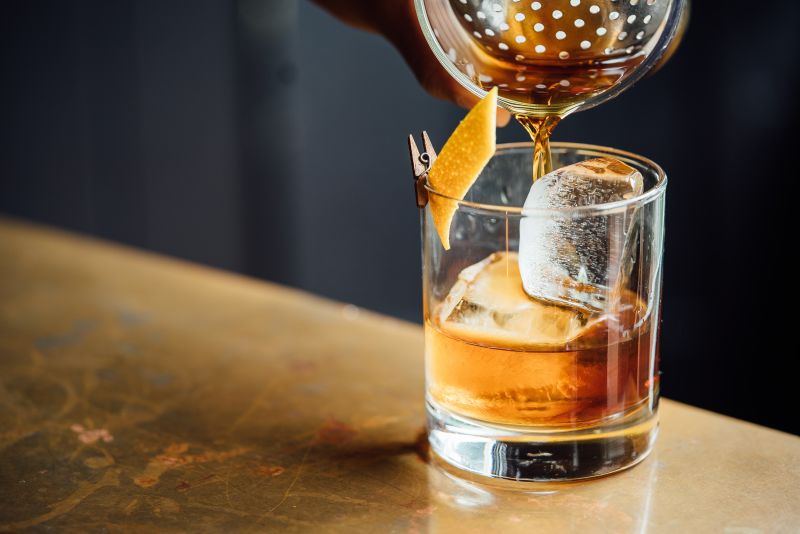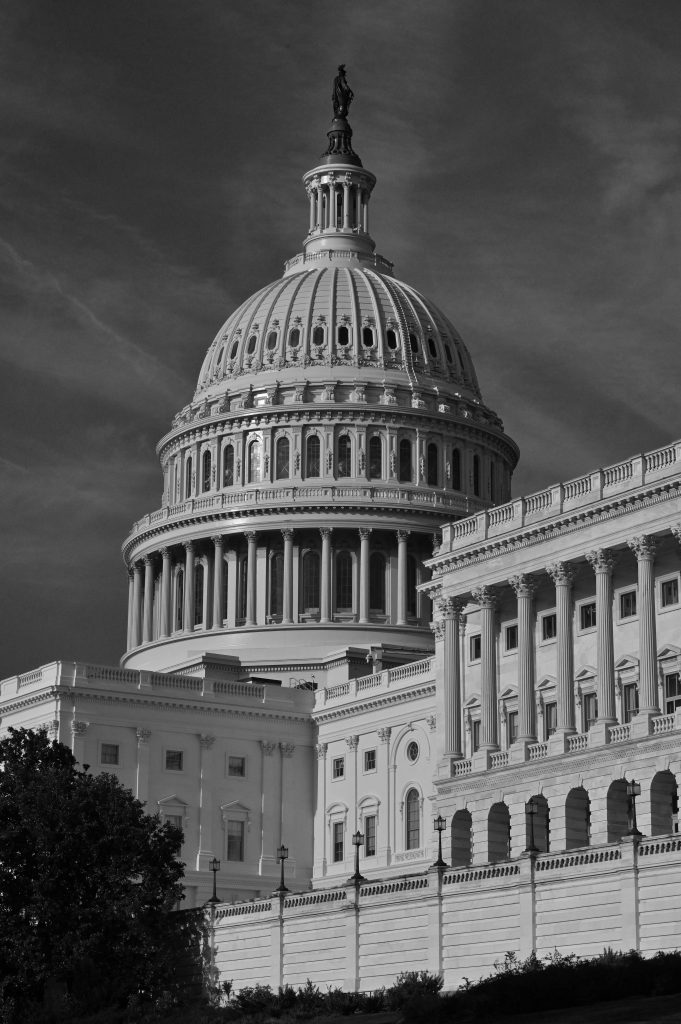Dog Eat Dog World: The First Amendment and Trademark Implications of VIP Products v. Jack Daniel’s

By Matthew Holt*
For over fifteen years, VIP Products (“VIP”) has sold rubber dog toys resembling an assortment of well-known beverage bottles and cans. These toys are known as the “Silly Squeakers” collection, and in July 2013, VIP released the Bad Spaniels dog toy.[1] This toy was designed to resemble the bottle of the classic Jack Daniel’s Old No. 7 whiskey bottle. The Bad Spaniels toy features the image of a spaniel over the words “Bad Spaniel” and also has the words “The Old No. 2 On Your Tennessee Carpet” where the Jack Daniel’s bottle has “Old No. 7 Brand Sour Mash Whiskey.”[2] Additionally the Bad Spaniels toy, instead of Jack Daniel’s labeling of “40% ALC BY VOL.” and “(80 PROOF),” has “43% POO BY VOL.” and “100% SMELLY” on the rubber bottle-shaped toy.[3] Over the past nine years, VIP and Jack Daniel’s Products, Inc. (“JDPI”) have been locked in a legal battle in which JDPI has alleged that VIP is infringing upon its trademark rights and has diluted its mark via tarnishment.
The Federal District Court of Arizona ruled on summary judgment that VIP was infringing on the Jack Daniel’s trademark using a likelihood of confusion test from Kendall-Jackson Winery, Ltd. v. E. & J. Gallo Winery, 150 F.3d 1042, 1046- 47 (9th Cir. 1998). This ruling enjoined VIP from “sourcing, manufacturing, advertising, promoting, displaying, shipping, importing, offering for sale, selling or distributing the Bad Spaniels dog toy.”[4] The Ninth Circuit then took the case on appeal and ruled in favor of VIP on the matters of trademark infringement and dilution by vacating and remanding the case regarding the trademark infringement ruling and reversing on the issue of dilution.[5] On March 22, 2023 the Supreme Court heard oral arguments in the matter of Jack Daniel’s Properties, Inc. v. VIP Products LLC. The issues that the Court will decide are “(1) Whether humorous use of another’s trademark as one’s own on a commercial product is subject to the Lanham Act’s traditional likelihood-of-confusion analysis, 15 U.S.C. § 1125(a)(1), or instead receives heightened First Amendment protection from trademark- infringement claims; and (2) whether humorous use of another’s mark as one’s own on a commercial product is “noncommercial” and thus bars as a matter of law a claim of dilution by tarnishment under the Trademark Dilution Revision Act, 15 U.S.C. § 1125(c)(3)(C).”[6]
This case is very important due to the future implications for First Amendment rights regarding parodies of trademarks. The case has evoked such passionate thoughts on both sides that there have been thirty amicus briefs filed from parties such as the Solicitor General, the International Trademark Association, law professors and other legal scholars, multiple global companies, and many others.[7] The reason so many parties have an interest in how this plays out comes down to what it could mean for companies and parody artists alike. Humorous parody is a form of expression that has been protected from infringement or dilution claims as “expressive” works or “noncommercial speech,” even when used on products that are sold.[8] This case could potentially put a damper on artists’ abilities to create parodies for products. However, an argument could be made that a brand’s image is also important, and works of parody that dilute the value of the brand or cause confusion to the source of the product could be a problem for companies.
Courts test trademark infringement by evaluating the potential infringement under a likelihood of confusion analysis.[9] However, since the ruling in the Rogers case, the Ninth Circuit has instituted a separate test for matters of parody. This is a two-prong test in which the court must decide whether the mark is either “not artistically relevant to the underlying work” or “explicitly misleads consumers as the source or content of the work.”[10] JDPI contends that this test should not apply here because the Lanham Act never establishes a “heightened standard” for expressive or humorous works.[11] JDPI also brings up that multiple circuits have either not adopted or have been unable to agree on when Rogers applies.[12] Its argument here carries some weight in that there does not seem to be a standard application for this test, nor is there a standard scope of items or products to which it applies.
Within the thirty amici briefs, there are varying opinions to what the test’s scope should be. Some argue it should only apply to book or movie titles; others argue it applies to any good that projects some kind of speech.[13] I think this plays a large part in why the Supreme Court granted certiorari, since this is an opportunity for the Court to clear up inconsistencies across the circuits. On the opposite side of JDPI’s claims, VIP brings forth arguments that the Rogers test is the appropriate measure for deciding whether infringement occurred in cases of parody and expression. VIP points to the various adoptions and refinements of the Rogers tests in some circuits to back up the notion that First Amendment expression is more important than trademark infringement when using marks expressively.[14]
As for the dilution claim, JDPI claims that pursuant to a prior Supreme Court case, Congress can “categorically prohibit trademark uses of a mark to protect the owner’s investment of ‘time, effort, and expense’ in the mark’s reputation.”[15] It claims that the dilution statute is designed to protect brands from harm coming from “incompatible associations.”[16] Here it cites the associations consumers would have between “whiskey, toys, and poop,” which JDPI argues would have a negative effect on its brand, even if the speech was positive.[17] VIP counters this by pointing out the potential damage to free speech if the court adopts JDPI’s perspective on the dilution claim. VIP discusses how a parody is specifically designed to poke fun at or disparage a brand and its reputation.[18] Furthermore, VIP points out that JDPI has given its mark meaning beyond source identification, and, pursuant to prior Ninth Circuit cases, has lost its “right to control public discourse.”[19]
Both sides present valid concerns, one worried about preserving decades of goodwill and brand building and the other wanting to protect free speech rights of parodists and society at large under the First Amendment. Ultimately, both sides present quality arguments as to why their interests should receive preferential treatment and how the precedent set could be detrimental to their industries and constitutional interpretations. Their arguments are correct in that the implications of the ruling could create new landscapes for trademark law and free speech in the world of parody. The importance of free speech protection to this iteration of the Court is an important stance for it to take, but the Court has shown unwillingness to make a decision regarding how far First Amendment protections go.[20] I am uncertain of how this case will shake out, but one thing I am sure of is that this case involving a simple dog toy will have implications for years to come and will make waves in the world of trademark law and free speech.
* J.D. Candidate, Class of 2024, Sandra Day O’Connor College of Law at Arizona State University.
[1] VIP Prods. Ltd. Liab. Co. v. Jack Daniel’s Props., 953 F.3d 1170, 1172 (9th Cir. 2020).
[2] Silly Squeakers® Liquor Bottles: Bad Spaniels, MYDOGTOY.COM, https://mydogtoy.com/p/Silly-Squeaker-Liquor-Bottle-Bad-Spaniels; Old No. 7, JACK DANIEL’S, https://www.jackdaniels.com/en-us/whiskey/old-no-7?_gl=1*1exn8sf*_up*MQ..&gclid=CjwKCAjwiOCgBhAgEiwAjv5whJL91_j1LAOyAkmPEetnMBZs CXq0c1WTCvVufdpFaPHos2OXFXpUnRoCAbAQAvD_BwE.
[3] Id.
[4] VIP Prods., LLC v. Jack Daniel’s Props., No. CV-14-2057-PHX-SMM, 2016 U.S. Dist. LEXIS 133387 (D. Ariz. Sept. 27, 2016).
[5] VIP Prods., 953 F.3d at 1176. See VIP Prods. LLC v. Jack Daniel’s Props., No. CV-14- 02057-PHX-SMM, 2021 U.S. Dist. LEXIS 232410 (D. Ariz. Oct. 8, 2021) (Upon remand, the District Court ruled for VIP on summary judgment regarding the trademark infringement claim after applying the standard from Rogers, as instructed by the Ninth Circuit.).
[6] Jack Daniel’s Properties, Inc. v. VIP Products LLC, SCOTUSBLOG, https://www.scotusblog.com/case-files/cases/jack-daniels-properties-inc-v-vip-products-llc-2/ (last visited Mar. 22, 2023).
[7] Id.
[8] Rogers v. Grimaldi, 875 F.2d 994 (2d Cir. 1989); Mattel, Inc. v. MCA Records, 296 F.3d 894 (9th Cir. 2002).
[9] Lanham Act 15 U.S.C. § 1125(a)(1).
[10] Rogers, 875 F.2d at 999.
[11] Reply Brief for Petitioner at 3, Jack Daniel’s Properties, Inc. v. VIP Products LLC, No. 22- 148 (U.S. Mar. 10, 2023).
[12] Id. at 5.
[13] Id. at 7-8.
[14] MGFB Props., Inc. v. Viacom Inc., 54 F.4th 670, 679 (11th Cir. 2022) (“the legislative history of the Lanham Act’s latest amendment states that the Rogers test ‘appropriately recognizes the primacy of constitutional protections for free expression.’” (quoting H.R. Rep. No. 116-645, at 20 (2020))).
[15] Reply Brief for Petitioner, supra note 11, at 21 (citing SFAA 483 US at 534-35).
[16] Id. at 20.
[17] Id.
[18] Brief of Respondent at 53, Jack Daniel’s Properties, Inc. v. VIP Products LLC, No. 22-148 (U.S. Mar. 10, 2023).
[19] Mattel Inc. v. Walking Mountain Prods., 353 F.3d at 907 (9th Cir. 2003) (quoting Mattel v. MCA at 900).
[20] Jane E. Kirtley, Mocking the Police Got an Ohio Man Arrested and the Supreme Court Won’t Define the Limits of Parody, OHIO CAP. J. (Mar. 1, 2023), https://ohiocapitaljournal.com/2023/03/01/mocking-the-police-got-an-ohio-man-arrested-and-the-supreme-court-wont-define-the-limits-of-parody/. See Novak v. City of Parma, 33 F.4th 296 (6th Cir. 2022).


